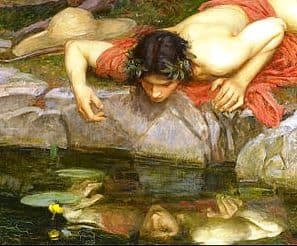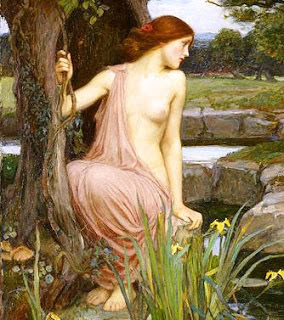Eco e Narciso são atuais e vale essa análise em tempos de selfies
As infinitas vantagens da internet é encontrar artigos encantadores como esse escrito por Gian Maria Zavattaro e Rossana Rollando. O tema parte de uma tela de John William Waterhouse, Eco e Narciso.
Selfies
Como narcisismo é muito atual, numa sociedade em que os selfies e curtidas que cultuamos nas redes sociais sem pudores é um reflexo do nosso egocentrismo, transcrevo o artigo para enriquecer nosso conhecimento, por outro lado, oferecer a oportunidade de apreciar um ponto de vista sobre a vida e o comportamento atual. Gian Maria Zavattaro é professor aposentado de uma escola estatal italiana.
Publicado originalmente em Persona e Comunità
“A tela que escolhemos para esse post se adapta ao conteúdo expresso. Nela, conta a história de Narciso e Eco. O primeiro é uma rapaz belo e destinado a não poder amar, que não seja a si mesmo, a segunda é a ninfa reduzida ao som que retorna. Narciso, depois de recusar Eco, perdidamente apaixonada por ele, morreu em uma fútil tentativa de abraçar o seu próprio reflexo em uma poça d’água.
John William Waterhouse
O autor da pintura é John William Waterhouse (1849-1917), pintor britânico rotulado como Pré-Rafaelita, que muitas vezes incorporava temas mitológicos com um toque delicado e pessoal e em cada caso, colocava à sua obra pictórica, textos literários, considerando a duas línguas – palavra escrita e palavra pintada – complementar.
 A imagem projetada
A imagem projetada
Uma certa tradição atribui a Buda a história de dois cães que em momentos diversos entram na mesma sala. Um saiu abanando o rabo e outro saiu rosnando.Uma mulher viu e curiosa entrou no quarto para descobrir o que fazia um feliz e o outro com tanta raiva. Com grande surpresa descobriu que o quarto estava cheio de espelhos. O cão feliz tinha encontrado uma centena de cães felizes olhando para ele, enquanto o cão com raiva tinha visto apenas cães raivosos que rosnavam para ele.
Qual é o significado dessa fábula? Depende do nosso modo de olharmos… Para Buda isso que vemos no mundo ao nosso redor é reflexo daquilo que nós somos: ‘Tudo aquilo que somos é reflexo daquilo que pensamos. A mente é tudo. Nos transformamos naquilo que pensamos’. A metáfora do espelho pode indicar muitos significados adicionais, alguns positivos, outros negativos.
Narciso
Pode evocar o fim trágico de Narciso: não sair do espelho quer dizer não sair de si mesmo, projetar sobre o outro nós mesmo, sem entrar em comunicação com o outro, reduzir o outro a si mesmo e afogar-se em si mesmo.
 Eco
Eco
Pode indicar o muro e a porta fechada de Sartre: o outro não é só o espelho e o reflexo dos meus pensamentos, mas é um estranho e não o meu reflexo, é diferente de mim, um estranho, o que está longe, o inimigo que é o inferno. A porta fechada. Eu perdi a chave e não tenho nada, que náuseas. Pode indicar um modo dramático de uma possível comunicação e comunhão: posso estabelecer uma ponte entre eu e o outro, posso conciliar as duas meias verdades que a fábula coloca em destaque, o outro que sou eu e o outro que não sou eu.
Narciso e Eco
Antes de fechar-se no quarto, o cachorro que rosnava já estava no mundo dos relacionamentos, somente na sua solidão, e na sala cheia de espelhos não contemplou o seu delírio e abandono e acabou colidindo com a multiplicação infinita de solidões. O cão “feliz” estava em primeiro lugar no mundo dos relacionamentos, em paz consigo mesmo e com os outros, aberto à comunicação e comunhão. No ambiente fechado da sala de espelhos apenas confirma a sua abertura ao mundo e da reconciliação consigo mesmo e com os outros. No labirinto do mundo, a metáfora dos espelhos, indica dois caminhos paradigmáticos: quando se entra na sala de si mesmo se espelha somente aquilo que somos fora. A divisão e a comunhão com os outros são consequências da paz e da laceração de nós mesmos”.














